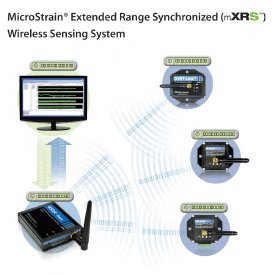Dec 6 2010
Today, MicroStrain introduces the extended range, synchronous wireless sensing system, combining breakthrough precision wireless time synchronization and enhanced system scalability accommodating hundreds of wireless sensor nodes with extended range communication.
The new MicroStrain Extended Range, Synchronized (mXRS) Wireless Sensing System currently includes 1)WSDA™-Base, a central base station that coordinates and synchronizes data collection with exceptional industry leading timing accuracy of up to +/- 31 microseconds; 2) Node Commander® 2.0 software with a wide range of user adjustable sample rates as well as the ability to facilitate high channel count data acquisition; and 3) a range of wireless sensor nodes that offer ultra-stable onboard precision timing and user configurable options for extended range communication to 1 kilometer.

According to MicroStrain President and CEO, Steve Arms, “We’ve developed truly groundbreaking technology that enables precisely synchronized, scalable wireless sensing systems. We’ve responded to customer requests to support many more nodes on a single radio frequency channel. And we greatly increased our system’s radio frequency communication range while providing fully programmable sampling and power saving options.”
Addressing the needs of a broad range of industries, these new systems enable information to be acquired from multiple sensors – either simultaneously, on varying schedules, or in bursts (to 100 KHz). All of this information is aggregated using time as a unifying variable. Applications include advanced condition based maintenance and structural health monitoring of heavy equipment, industrial machines, aircraft, civil structures, vehicles, and wind turbines. For more information, visit http://microstrain.com/wireless-sensors.aspx.
MicroStrain, Inc is a privately held corporation based in Williston Vermont. MicroStrain produces smart, wireless, micro-miniature displacement, orientation and strain sensors. Applications include advanced automotive controls, health monitoring, inspection of machines and civil structures, smart medical devices and navigation/control systems for unmanned vehicles, and energy harvesting technologies.